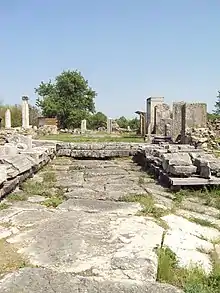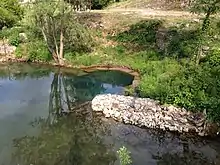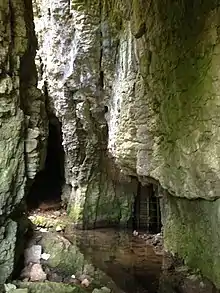Nicopolis ad Istrum
Nicopolis ad Istrum (Greek: Νικόπολις ἡ πρὸς Ἴστρον) or Nicopolis ad Iatrum[1][2] was a Roman and Early Byzantine town.
Νικόπολις ἡ πρὸς Ἴστρον | |
 | |
 Shown within Bulgaria | |
| Coordinates | 43°13′02″N 25°36′40″E |
|---|---|
| History | |
| Builder | Trajan |
| Founded | 101–106 A.D. |
| Abandoned | 447 A.D. |
Its ruins are located at the village of Nikyup,[3] 20 km north of Veliko Tarnovo in northern Bulgaria. The town reached its zenith during the reigns of Hadrian, the Antonines and the Severan dynasty.
Archaeological excavations are continuing to reveal more of the city.
The site was placed on the Tentative List for consideration as a World Heritage Site by UNESCO in 1984.
History



The site was at the junction of the Iatrus (Yantra) and the Rositsa rivers, where the Roman army under Emperor Trajan had been amassed in readiness for the attack in the winter of 101-2 to the Roxolani tribe from north of the Danube and who were allied to the Dacians.[4][5]
The city was founded by Trajan around 102–106, as indicated on scene XXXIX of Trajan’s Column, in memory of his victory in the Dacian Wars over the Roxolani and also later victories in 105, and as Ulpia Nicopolis in his honour using his family name, or nomen. However the name Nicopolis ad Haemum was used in Ptolemy's Geographia dating from before 130.[6]
Trajan clearly intended it to become a magnificent city which is gradually being verified. The monumental character of the city however dates mainly to Hadrian and Antoninus Pius (138-161) and inscriptions found are no earlier than 136 when the name Ulpia Nicopolis ad Istrum was in use. The new agora included a monumental ionic stoa and a sumptuous hall of unknown function.
The city was ransacked by the Costoboci in 170-1,[7] a tribe from today’s Western Ukraine, shortly after which the city walls were built.[8] Many buildings were excluded from the walled area from this time.
The city prospered again in the 2nd and 3rd centuries under the Severan dynasty (193-235). In 193 the city endowed Septimius Severus, then still pretender to the throne, with 700000 denarii (a fortune at the time) for which a copy of the letter of thanks to the city from the emperor, after he succeeded, is recorded in an inscription. He made several visits to the city subsequently.
However from about 212 the honorary title Ulpia was no longer used in public inscriptions which is believed to be a result of Caracalla's displeasure with the city[9] after his visit there in 211-212.[10] Caracalla closed the mint and it lost its status of civitas stipendaria as well as its economic prosperity. After his death the city organised games for the new emperor and as a result it seems that the city regained its civic status, though not its full name, and re-opened the mint,[11][12] issuing coins bearing images of its public buildings.[13]
In 250 near the city, emperor Decius defeated the Goths under Cniva at the Battle of Nicopolis ad Istrum.[14]
Nicopolis grew further as a major urban centre under Emperor Diocletian's (284-305) reforms. Nevertheless at least the north wing of the agora was damaged during the 3rd century.
Under Constantine from 306 the damaged northern agora buildings were replaced by two built with opus mixtum masonry, divided into three aisles by rows of large pillars, which may well have been horrea (warehouses), given that other nearby cities (e.g. Tropaeum and Zaldapa) also received horrea rather than basilicas in the same period. These horrea probably formed part of the large supply network for the Danube army helped by building a large number of horrea in the late 3rd and early 4th centuries.[15]
In 447, the town was destroyed by Attila's Huns.[16] Perhaps it was already abandoned before the early 5th century.[17]
In about the middle of 5th century after the Huns' invasion, new high and strong walls were built adjoining the southern wall of the old city.[17] It seems that by then the old walls were in poor condition and repairing them was not viable. Moreover, their considerable length of 1.8km required more defenders than were available. The new city had an area of 1/4 of the original city enclosing little more than military buildings and churches, following a very common trend for the cities of that century in the Danube area.[18] The larger area of the extensive ruins (21.55 hectares) of the classical Nicopolis was not reoccupied. The south wall of the old city was reconstructed as the north wall of the new one. Its towers were built upon destroyed and abandoned buildings, and ornamented stone blocks from their facades were used in the new structures. The towers were about 15m in front of the 10m high wall. The outside of the wall was rendered with mortar with incised grooves imitating massive stone blocks. The old south gate later also underwent a major reconstruction to compensate for higher surrounding terrain as the gate was situated in a hollow.[19]
The town became an episcopal centre during the early Byzantine period. The names of two of the early bishops of the city are known: Marcellus (in 451) and Amantius (in 518).[20]
The city was destroyed by the Avars and Slavs in the late 7th c. during the Avar–Byzantine wars. A small Bulgarian settlement later arose upon its ruins (9th-14th century).[13]
Nicopolis ad Istrum can be said to have been the birthplace of Germanic literary tradition. In the 4th century, the Gothic bishop, missionary and translator Ulfilas (Wulfila) obtained permission from Emperor Constantius II to immigrate with his flock of converts to Moesia and settle near Nicopolis ad Istrum in 347-8.[21] There, he devised the Gothic alphabet and oversaw the translation of the Bible from Greek to Gothic, which was performed by a group of scholars.[22][23]
Archaeology


The classical town was planned according to the orthogonal system. The network of streets, the forum surrounded by an Ionic colonnade and many buildings, a two-nave room later turned into a basilica and other public buildings have been uncovered. The rich architectures and sculptures show a similarity with those of the ancient towns in Asia Minor.
The agora contained a statue of Trajan on horseback as well as other marble statues and an Ionic colonnade. The city also had a three-nave basilica, a bouleuterion, a temple of Cybele, a small odeon, thermae (public baths) as well as a unique Roman building inscribed with termoperiatos, a heated building with shops and enclosed space for walks and business meetings. Some town houses and buildings have also been excavated.
A unique public building, a thermoperipatos, has been identified only in Nicopolis ad Istrum so far, out of all cities in Roman Empire. It occupied a whole insula and was built under Commodus in 184-5 on the ruins of an earlier building. It was probably used for tradng and included shops. It was ruined in the 4th c. and another building later built over it.
The city was supplied by three aqueducts and had several water wells, many of which have been unearthed in archaeological excavations. The western aqueduct of 25km length had a bridge of almost 3km long and almost 20m tall carrying water over the entire valley of the Rositsa River.[24] Its 2nd century water catchment reservoir is located near the town of Musina in Pavlikeni municipality, to the west of the Roman city, where it still collects water from the karst springs inside the Musina Cave. A large castellum aquae of this aqueduct stands to the west of the city.
In 2015 remains of a huge building were revealed which was probably the residence of the agoranomus or curule aedile, a public officer in charge of trade and market operations in Ancient Greek and Roman cities.[25]
The obelisk of Quintus Julius, an aristocrat from Nicopolis, still stands to a height of 14m in the countryside near Lesicheri, about 12km west of the city.[26]
Many finds are on display in the Veliko Tarnovo Regional Museum of History.
In 2018, archaeologists found an altar dedicated to the goddess Tyche at a small square in the southwestern corner of the Forum complex, with an inscription in Ancient Greek which is a modified epigram by Demosthenes.[27]
Gallery
 Overview of the ruins of Nicopolis ad Istrum
Overview of the ruins of Nicopolis ad Istrum A pediment with a relief image
A pediment with a relief image A Roman street, one of the city's main streets running north–south
A Roman street, one of the city's main streets running north–south The main city drain
The main city drain
Notes
- Nikopol - variant names
- James Playfair, A System of Geography, Ancient and Modern (Hill 1812), vol. 4, p. 542
- See bg:Никюп and de:Nikjup
- About the Roman frontier on the Lower Danube under Trajan, Ovidiu ŢENTEA, MOESICA ET CHRISTIANA, Studies in Honour of Professor Alexandru Barnea Edited by Adriana Panaite, Romeo Cîrjan and Carol Căpiţă, Muzeul Brăilei, pp. 85-93, ISBN 978-606-654-181-7
- Ammianus Marcellinus. 3.5.16
- Simeonov Topalilov: A Note on the Name of Nicopolis ad Istrum, Open Archaeology 2018; 4: 340–34, https://doi.org/10.1515/opar-2018-0021
- Archaeologists Impressed with Ancient Water Catchment Reservoir Which Fed 20-km-Long Aqueduct of Major Roman City Nicopolis ad Istrum in North Bulgaria: http://archaeologyinbulgaria.com/2018/03/06/archaeologists-impressed-ancient-water-catchment-reservoir-fed-20-km-long-aqueduct-major-roman-city-nicopolis-ad-istrum-north-bulgaria/
- Ruscu, Ligia Cristina. "On Nicopolis AD Istrum and Her Territory." Historia: Zeitschrift Für Alte Geschichte 56, no. 2 (2007): p 215. www.jstor.org/stable/25598389.
- Topalilov, Ivo. (2007). Ulpia Nicopolis ad Istrum and Claudia Leucas: two examples with drawn peregrine city-titles. https://www.researchgate.net/publication/232708741_ULPIA_NICOPOLIS_AD_ISTRUM_AND_CLAUDIA_LEUCASTWO_EXAMPLES_WITH_DRAWN_PEREGRINE_CITY-TITLES
- Boteva, D. 1997. Lower Moesia and Thrace in the Roman Imperial System (A.D. 193-217/218). Sofia, pp 281-82
- Mouchmov, N. 1912. The Ancient Coins of the Balkan Peninsula and the Coins of the Bulgarian Kings. Sofia, 1281.
- Vagalinski. L. 1994. “Donnés numismatiques pour des compétitions sportives en Thrace romaine.” Arheologija 3-4: 6-18, 16
- UNESCO.ORG
- The Cambridge Medieval History, Joan Mervyn Hussey p 204, CUP Archive, 1957
- Jahrbuch des Römisch-Germanischen Zentralmuseums Mainz 60. Jahrgang 2013, Efthymios Rizos: Centres of the late roman military supply network in the Balkans: a survey of horrea p 676
- Burns (1994), 38
- Curta (2001), 158
- Liebeschuetz (2001), 77
- Ivan Tsarov: "Ulpia Nicopolis ad Istrum ~ Cultural and Historical Heritage Library" Slavena Publishing House, Varna, 2009, ISBN 978-954-579-779-8
- Daniele Farlati and Jacopo Coleti, Illyricum Sacrum (Venice 1819), vol. VIII, pp. 106-107
- Burns (1994), 37
- Peter Heather, J. The Fall of the Roman Empire: A New History of Rome and the Barbarians, Oxford University Press, 2005, 78. ISBN 0-19-515954-3
- Ratkus, Artūras (2018). "Greek ἀρχιερεύς in Gothic translation: Linguistics and theology at a crossroads". NOWELE. 71 (1): 3–34. doi:10.1075/nowele.00002.rat.
- Ivan Tsarov: “The Aqueducts in the Bulgarian Lands, 2nd-4th century AD” ISBN 9786191681907
- http://archaeologyinbulgaria.com/2016/01/27/archaeologists-unearth-huge-agoranomuss-building-in-ancient-roman-city-nicopolis-ad-istrum-near-bulgarias-nikyup/
- http://archaeologyinbulgaria.com/2016/04/08/archaeologists-seek-to-restart-excavations-of-ancient-roman-obelisk-from-late-antiquity-mausoleum-near-bulgarias-lesicheri/
- ALTAR OF DESTINY GODDESS TYCHE WITH DEMOSTHENES EPIGRAM INSCRIPTION FOUND IN ANCIENT ROMAN CITY NICOPOLIS AD ISTRUM IN BULGARIA
References
- Burns, Thomas, S. Barbarians Within the Gates of Rome: A Study of Roman Military Policy and the Barbarians, ca. 375-425 A.D., Indiana University Press, 1994. ISBN 0-253-31288-4
- Curta, Florin (2001). The Making of the Slavs: History and Archaeology of the Lower Danube Region, c. 500–700. Cambridge: Cambridge University Press.CS1 maint: ref=harv (link)
- Liebeschuetz, J.H.W.G. The Decline and Fall of the Roman City, Oxford University Press, 2001. ISBN 978-0-19-926109-3
- The ancient town of Nicopolis ad Istrum at UNESCO.ORG
Further reading
Poulter, Andrew. Nicopolis ad Istrum: A Roman, Late Roman and Early Byzantine City (Excavations 1985-1992), Society for the Promotion of Roman Studies, London, 1995. ISBN 0-907764-20-7
External links
| Wikimedia Commons has media related to Nicopolis ad Istrum. |
- Klearchos Kapoutsis on Nicopolis ad Istrum - Part 1
- Klearchos Kapoutsis on Nicopolis ad Istrum - Part 2
- Klearchos Kapoutsis on Nicopolis ad Istrum - Part 3